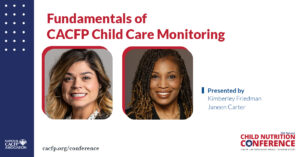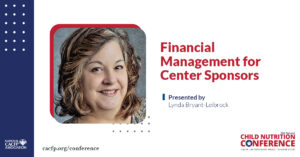2025 NCNC
Fundamentals of CACFP Child Care Monitoring
Learn about pre-visit preparation steps, what to look for while on-site (such as adherence to meal patterns, meal counting, documentation, and civil rights requirements), record retention requirements, and follow-up activities. Recorded on form H1606 in Texas, this tool may be modified for use by other states and as a guide for any sponsoring organizations.
Read MoreAdministrative Review Preparedness for Sponsors
Effective program compliance ensures the success of CACFP and SFSP. What are some of the do’s and don’ts of preparing for an administrative review? Hear lessons learned from administrative review examiners and get recommendations for how sponsors can be better prepared in the future.
Read MoreSponsoring Summer Food: Keys to Financial Management
You’re already working in the food program and are ready to expand to summer feeding. Hear about best practices to ensure proper internal controls for successful financial management and mitigate high risk program areas.
Read MoreNavigating Specific Prior Written Approvals for Budget Items
Are you new to the CACFP or looking for a way to up your game when it comes to Specific Prior Written Approvals (SPWA)? Get a comprehensive overview of the process including insight on the requirements, steps for compliance, and best practices for tracking and reporting. Extend your knowledge to ensure adherence to the budgetary regulations for your purchased items or services.
Read MoreInvestigating Fraud, Waste & Abuse in Federally Funded Programs
Gain insight on investigating allegations of non-compliance in the CACFP and SFSP. Learn how to identify red flags during a monitoring review and take home interview techniques, sampling methodologies, and best practices which have been instrumental in identifying fraud, waste, and abuse in federally funded programs.
Read MoreFinancial Management for Center Sponsors
Ensuring program compliance with proper accounting systems is essential for success in the CACFP. Discover strategies for establishing internal controls for effective financial management. Get best practices and an increased awareness of the importance of recordkeeping and documentation.
Read MoreBest Practices for Developing a Financial Management Process
Financial management is an important factor in the success of CACFP and SFSP. But should sponsors’ financial management process be proactive or reactive? Get practical recommendations on how sponsors can implement financial management best practices.
Read MoreMonitoring 101: Ensuring Compliance in SFSP and Afterschool Meals
Ready to level up your understanding of monitoring in SFSP or After School Meals? Whether you are a beginner or a veteran who never stops studying, discover key points of monitoring compliance, along with tips to be successful in audits, and put your knowledge on display while maximizing reimbursements for your programs.
Read MoreMaximizing Meal Access in the Out-of-School Time Hours
With childhood hunger on the rise in the wake of the pandemic, it is more important than ever to reinvest in child nutrition programs, particularly those that take place outside of the normal school day. Discover strategies to expand access and bolster participation in the Summer and Afterschool Nutrition Programs from a panel of youth-serving organizations and national non-profits
Read MoreExpanding Your Afterschool Meals Program for Greater Impact
Discover how a local food program, in just five years, skyrocketed from serving 500 meals daily to 2,000. Learn how they cut costs, reduced waste, and maximized efficiency using ready-made food, all while collaborating with community sites and education leaders to expand their program’s impact.
Read More









